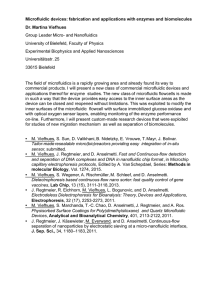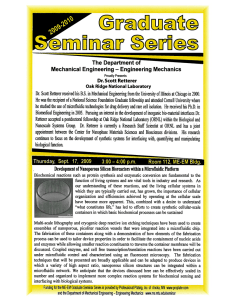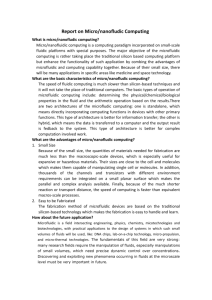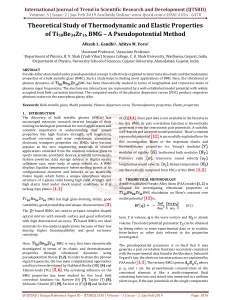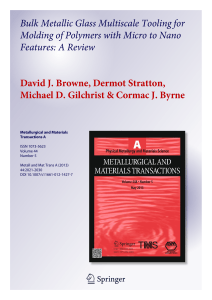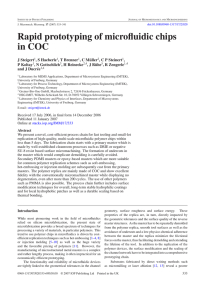POLYMER INJECTION MOLDING OF MICRO/NANO STRUCTURED
advertisement
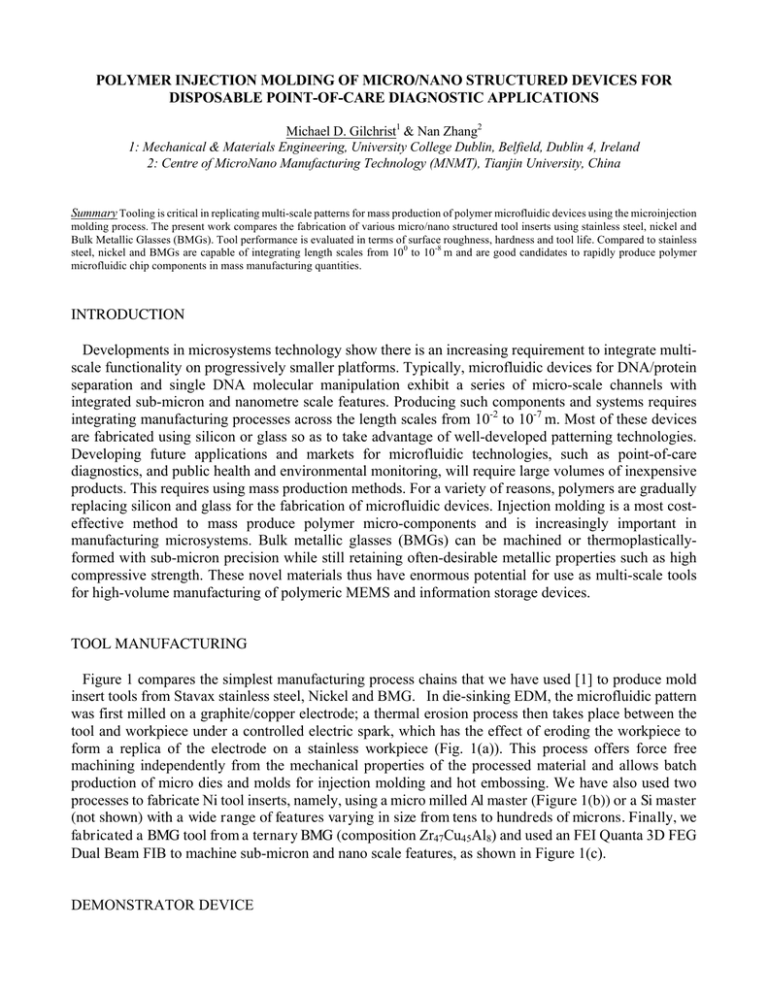
POLYMER INJECTION MOLDING OF MICRO/NANO STRUCTURED DEVICES FOR DISPOSABLE POINT-OF-CARE DIAGNOSTIC APPLICATIONS Michael D. Gilchrist1 & Nan Zhang2 1: Mechanical & Materials Engineering, University College Dublin, Belfield, Dublin 4, Ireland 2: Centre of MicroNano Manufacturing Technology (MNMT), Tianjin University, China Summary Tooling is critical in replicating multi-scale patterns for mass production of polymer microfluidic devices using the microinjection molding process. The present work compares the fabrication of various micro/nano structured tool inserts using stainless steel, nickel and Bulk Metallic Glasses (BMGs). Tool performance is evaluated in terms of surface roughness, hardness and tool life. Compared to stainless steel, nickel and BMGs are capable of integrating length scales from 100 to 10-8 m and are good candidates to rapidly produce polymer microfluidic chip components in mass manufacturing quantities. INTRODUCTION Developments in microsystems technology show there is an increasing requirement to integrate multiscale functionality on progressively smaller platforms. Typically, microfluidic devices for DNA/protein separation and single DNA molecular manipulation exhibit a series of micro-scale channels with integrated sub-micron and nanometre scale features. Producing such components and systems requires integrating manufacturing processes across the length scales from 10-2 to 10-7 m. Most of these devices are fabricated using silicon or glass so as to take advantage of well-developed patterning technologies. Developing future applications and markets for microfluidic technologies, such as point-of-care diagnostics, and public health and environmental monitoring, will require large volumes of inexpensive products. This requires using mass production methods. For a variety of reasons, polymers are gradually replacing silicon and glass for the fabrication of microfluidic devices. Injection molding is a most costeffective method to mass produce polymer micro-components and is increasingly important in manufacturing microsystems. Bulk metallic glasses (BMGs) can be machined or thermoplasticallyformed with sub-micron precision while still retaining often-desirable metallic properties such as high compressive strength. These novel materials thus have enormous potential for use as multi-scale tools for high-volume manufacturing of polymeric MEMS and information storage devices. TOOL MANUFACTURING Figure 1 compares the simplest manufacturing process chains that we have used [1] to produce mold insert tools from Stavax stainless steel, Nickel and BMG. In die-sinking EDM, the microfluidic pattern was first milled on a graphite/copper electrode; a thermal erosion process then takes place between the tool and workpiece under a controlled electric spark, which has the effect of eroding the workpiece to form a replica of the electrode on a stainless workpiece (Fig. 1(a)). This process offers force free machining independently from the mechanical properties of the processed material and allows batch production of micro dies and molds for injection molding and hot embossing. We have also used two processes to fabricate Ni tool inserts, namely, using a micro milled Al master (Figure 1(b)) or a Si master (not shown) with a wide range of features varying in size from tens to hundreds of microns. Finally, we fabricated a BMG tool from a ternary BMG (composition Zr47Cu45Al8) and used an FEI Quanta 3D FEG Dual Beam FIB to machine sub-micron and nano scale features, as shown in Figure 1(c). DEMONSTRATOR DEVICE Based on the separation principle using electrophoresis [2], a demonstration chip was designed, as shown in Figure 15. The mixed sizes of DNA molecules are injected into the top two square chambers (Figure 2). Once the voltage is applied to DNA, the charged DNA molecules move to the other end chamber. The chip contains multi scale features including sub micron pillar arrays. The presentation will describe the manufacturing of this component and will discuss high volume processing issues. (a) (b) (c) Figure 1. Process chains for manufacturing tool inserts. (a) Micromilling of graphite/copper electrode and die-sinking EDM of stainless steel; (b) machining of an aluminium master with trenches using micromilling and the subsequent creation of a Ni insert tool with inverted trench patterns by electroforming and dissolving of Al; (c) direct Focussed Ion Beam milling on a BMG workpiece. Figure 2. Demonstrator nanofluidic design (polymer component) manufactured in HDPE via injection molding using BMG insert tool. CONCLUSIONS A prototype BMG injection molding tool capable of producing centimeter long polymeric components, with sub-micron surface features has been used to manufacture a nanofluidic component. This offers significant potential for commoditizing next generation diagnostic devices. References 1. Zhang N, Srivastava A, Kirwan B, Byrne R, Fang F, Browne DJ, Gilchrist MD, J. Micromech. Microengng. 25 095005, 2015. 2. Baba M, Sano T, Iguchi N, Iida K, Sakamoto T, Kawaura H, Appl. Phys. Lett., 83 1468-70, 2003.
